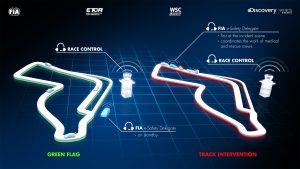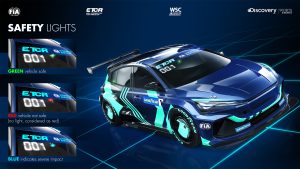The FIA ETCR eTouring Car World Cup is not only at the forefront of technology, it’s also leading the way when it comes to safety with the FIA working in close collaboration with WSC Group.
Leaning on the experience gained over the years of managing high-voltage technologies in motor sport, a set of high voltage safety procedures were developed in order to mitigate associated risks at FIA ETCR events. With batteries running in the region of 800V, the ETCR-spec cars are in the high-voltage domain and therefore require specific attention and care.

In terms of operational safety, the FIA has studied existing high voltage safety regulations and consulted experts from the field to develop the new FIA e-safety regulations covering equipment, procedures and briefings for all, from officials and volunteers to medical, rescue and recovery crews.
A new role – the FIA e-Safety Delegate – was also created to oversee the implementation of the new regulations and procedures, to ensure compliance of the installation and teams’ equipment, to deliver e-safety briefings and to coordinate on-track interventions.
During all sessions, the FIA e-Safety Delegate will remain on standby in the pits. If an incident occurs, the FIA e-Safety Delegate will be the first person on-site to coordinate rescue and recovery procedures while remaining in contact with Race Control.
All FIA operational staff, including officials and volunteers, must attend a mandatory FIA e-safety briefing delivered on-site. In addition, an online e-learning platform is available prior to the event. These briefings cover areas such as presentation of the cars’ technology and associated risks of high voltage, personal protective equipment, safety lights and switches as well as an overview of relevant FIA regulations (including sporting regulation and appendices to the International Sporting Code), in-depth breakdown of procedures and clarification of responsibilities.

Additionally, on-site practical training and simulation exercises will be conducted ahead of every event. This includes the so-called “red car exercise” and extrication exercises held under the supervision of the FIA Medical Delegate and with the support of the FIA e-Safety Delegate. The purpose is to simulate critical situations involving high-voltage risks.
As with other FIA competitions featuring electric and hybrid-powered vehicles, the cars feature a safety light system indicating when the vehicle is safe to touch. The lights are built into the top part of the windscreen as well as to both side windows of a car. Additionally, another display is placed on the dashboard, in sight of a driver. Finally, the telemetry enables Race Control to have instant information on the state of each car, ensuring readiness for emergency response.

Overall, the FIA e-Safety Regulations’ main purpose is to ensure the entire organisation is set up and ready to face and manage efficiently any event related to high-voltage risk, focusing on volunteers, officials, teams and drivers.
“The number of motor sport competitions using electric and hybrid powertrains is increasing, therefore management of the risks associated with high-voltage technologies is an important area form a safety standpoint,” explains the FIA Safety Director, Tim Malyon.

“This is something that has been at the forefront of the work of the FIA’s Safety Department in recent years. I am glad we have been able to establish a number of regulations and procedures which aim to ensure the risks of high voltage technologies are well understood and managed by all involved, be those competitors, officials or spectators.”
